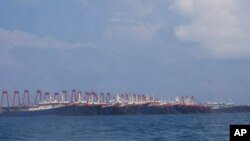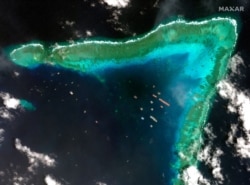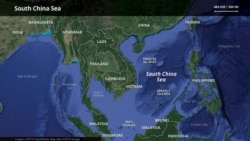A Philippine demand for the removal of 220 fishing Chinese vessels spotted in a contested sea has further hurt relations between two Asian countries that had gotten along just fine years ago, despite the simmering maritime dispute, analysts believe.
According to the state-funded People’s Television Network in Manila, a Philippine government task force “expressed concern” that the Chinese fishing flotilla had reached a reef in the Spratly Islands of the South China Sea and the country's defense chief demanded that they leave. Chinese “maritime militia” were believed to be with the ships when they approached the unoccupied reef March 7, the network said.
Defense officials contacted a Chinese counterpart Wednesday as 183 boats remained at the reef this week, the Armed Forces of the Philippines said Thursday on its Facebook page. “We conveyed the defense secretary’s demand for the vessels to leave,” the Facebook page says.
Philippine President Rodrigo Duterte met with the Chinese ambassador earlier in the week to raise concern about the number of boats and vow that he would defend his country. The ambassador said the boats are operated by fishermen seeking shelter, presidential office spokesman Harry Roque told a news briefing Thursday.
Manila’s discovery of the boats deepens a decline in Sino-Philippine goodwill that peaked after Duterte took office five years ago, analysts say.
The Chinese vessels are “definitely having an impact,” said Jay Batongbacal, international maritime affairs professor at the University of the Philippines.
“For sure many in government, even among many Duterte supporters, are not as enamored with China because of this,” he said.
The flotilla reminds many Filipinos of 2012, when Chinese vessels occupied Scarborough Reef, a fishery in the contested South China Sea, sparking a lengthy standoff, Batongbacal said.
Duterte sought Chinese aid and investment in 2016 to accelerate economic development. Beijing wanted Manila to set aside their maritime sovereignty dispute after an international tribunal ruled against the legal basis for Chinese claims to 90% of the 3.5 million-square-kilometer waterway.
The reef where the Chinese boats are holding is 859 kilometers southwest of Manila and just dozens of kilometers from the 10 Spratly islets under day-to-day Philippine control.
Sino-Philippine relations had already weakened over perceptions among Filipinos that $24 billion that China pledged in aid and investment was reaching them too slowly.
A Chinese vessel had caused alarm in 2017 by planting a 3-meter-high flag on Sandy Cay in a Philippines-controlled area of the Spratly Islands, a congressman in Manila said at the time. Two years ago, China allowed more than 100 fishing boats to pass through the Spratly Islands.
A mid-2020 survey by Quezon City-based research institution Social Weather Stations found that Filipinos’ “trust” in China fell from “poor” to “bad” with a net trust rating of -36. It was the lowest showing since April 2016, two months before Duterte took office.
The 2020 survey took place amid “aggressive” Chinese acts in the sea, domestic media outlet Rappler.com said.
Officials in Beijing are bristling too. They resent the United States for helping the Philippines militarily, said Carl Thayer, an emeritus professor from the University of New South Wales in Australia. Duterte still allows annual Philippines-U.S. military exercises, despite talk years ago of ending them, and last year his government deferred plans to cancel a visiting forces agreement with the U.S. military.
The United States periodically sends warships and aircraft to the sea as support for pro-U.S. governments such as Taiwan and the Philippines. China intends its 220-boat flotilla to challenge the U.S.-Philippines military connection, Thayer said.
In Beijing this past Monday, Chinese Foreign Ministry spokeswoman Hua Chunying said her country’s fishing boats “have been fishing in the waters near (Whitsun) reef all along and that “recently, due to maritime situation, some fishing boats have been taking shelter from the wind…which is quite normal.”
Brunei, Malaysia, Taiwan and Vietnam also claim all or parts of the South China Sea. They look to the waters for fisheries and undersea fuel reserves. Beijing, which cites historical usage records to back its claims, has alarmed the other governments by landfilling islets for development, including military infrastructure.
Within the Philippine navy alone now, “people express views at odds with Duterte, on China,” said Thayer, who has attended conferences with navy personnel. “They’re humiliated and they’re upset.”
Sino-Philippine relations continue, however, as the Philippines needs Chinese COVID-19 vaccines and aid with post-pandemic economic recovery, said Yun Sun, East Asia Program senior associate at the Stimson Center in Washington. China was aiming as of mid-December to send the Philippines 25 million doses of the Chinese-made Sinovac vaccine by this month.
“Although the relationship between China and the Philippines is rocky currently because of the 220 fishing boats, I don’t think we’re at the breaking point just yet,” Sun said.







